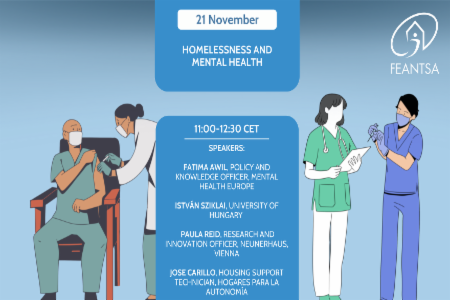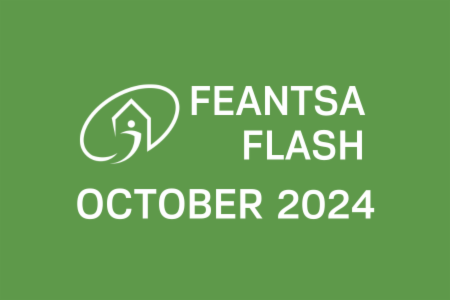The Digital Education Action Plan 2021-2027
Digital inclusion as a way to enhance social inclusion of homeless people
Read and download the PDF here
On 30th September 2020, the European Commission published a Communication on the ‘Digital Education Action Plan 2021-2027: Resetting education and training for the digital age’. The Action Plan sets a total of 14 actions within two strategic priorities: i) to foster the development of a high-performing digital education ecosystem and ii) to enhance digital skills and competences for the digital transformation of society.
The relevance of the Digital Education Action Plan is clearly stated in the Communication: “the digital transformation is reshaping society, the labour market and the future of work”[1]. With the outbreak of the pandemic, the digital world has become even more important: up to 95% of the respondents to the consultation on the Action Plan considered the pandemic a ‘turning point’ in education and training. The Action Plan also notes that the opportunities brought about by digitalisation are not always available to everyone. For example, demographics who are socially excluded are at risk of being left behind in a digitalised world. Studies show how digital exclusion and social exclusion are intertwined; research commissioned by the Carnegie UK Trust in 2016 found that, among others, those who are socially excluded are less likely to use and benefit from the internet, which has the potential to be a resource in tackling exclusion and consequently, digital exclusion may exacerbate existing social exclusion[2].
Today, the 25th of February 2021, on Digital Learning Day, FEANTSA welcomes the efforts of the European Commission to promote digital education as key to increase equality and inclusivity, and commends the EC on their work to ensure that all citizens achieve basic digital skills[3]. At FEANTSA, we support digital inclusion for all, and we underline the existing need to analyse how ICT tools can be used to bridge the digital and social inclusion gap which impacts vulnerable groups and homeless people. The COVID-19 pandemic has accelerated the digital transformation and triggered rapid, large-scale changes, pushing many services online and ushering in a new and more digitalised lifestyle. The most vulnerable individuals in our society - homeless people included - should not be further excluded and marginalised during this crisis as a result of the digitalisation process.
On Digital Learning Day, FEANTSA underlines the need to implement targeted measures to increase the level of participation in digitalisation among vulnerable communities, and we call for: i) the availability of digital opportunities to everyone, including the most vulnerable populations, such as people experiencing homelessness; and for ii) non-formal digital education to be addressed to allow for better access to digital skills for the homeless and the professionals who support them, e.g. through facilitating training courses in charities, homeless service providers or NGOs.
ICT (Information and Communications Technology) can present great benefits for people experiencing homelessness and housing exclusion. For the general population, access to ICT is becoming increasingly important for tasks like searching for a job, accommodation or health care and other basic services. For people experiencing homelessness, access to ICT is also essential for keeping in touch with family, friends, social workers, or peer-support groups, to get information about where to eat and sleep and finally, to find a way out of homelessness too[4]. At FEANTSA we collected a series of good practices regarding provision of ICT tools for vulnerable groups and homeless people, which have improved access to information in multiple languages and empowered people to navigate new systems.
The pandemic has emphasised the importance of access to ICT. For people experiencing homelessness, being connected can mean saving their lives. Among other things, being connected means quick access to information and health advice, professional assistance when many public services and charities are closed, or the possibility of finding emergency accommodation or food. Having virtual connection with other people is also very important in terms of mental health, especially when mental health problems are more common in homeless people than in the general population, with a sharp disparity in suicidal rates[5]. Digital devices are also very important for maintaining direct contact with essential services, especially during the pandemic. For example, people with mobile phones can be contacted by their GPs or social workers or receive notifications on vaccination and health advice, through text messages and/or app notifications[6].
Children and family homelessness is an issue across MS and as schools have shut down during the pandemic, youth and children experiencing homelessness need access to ICT to follow online lessons. Migrants in homelessness also need ICT for a number of reasons, including to gain access to information about shelters, connect with their families, get immigration advice or to have information translated into their own language, among others[7].
It is important to make online opportunities available for homeless people, as digital inclusion can act as a means to leave social exclusion.
Nevertheless, available research points to challenges for many people in homelessness in relation to ‘inputs’ (i.e. resources needed to make full use of devices) and/or their digital skills, which makes it very difficult for them to fully exercise their digital rights and enjoy opportunities offered by ICT[8]. In relation to ‘inputs’, the main obstacles are: a lack of the necessary documentation to sign a contract and/or an address to pay for bills, insufficient mobile data, limited Wi-Fi in shelters, public services, fast-food restaurants, etc.; lack of charging stations, affordability of data and devices, or online security with public Wi-Fi networks, among others. In relation to digital skills, digital illiteracy is an issue for many individuals, as well as webpages or applications which are not designed to engage marginalized users, and lack of access to some critical services via digital devices.
The Digital Education Action Plan 2021-2027 can enhance digital inclusion of homeless people by adopting several measures that allow for better access to ICT, and improved digital skills for homeless people and the services that support them.
These measures around digital inclusion would be in line with the European Pillar of Social Rights and the European Commission’s work programme for 2021. Chapters I & III of the EPSR state that all citizens shall have access to equal opportunities in education and training skills, to improve their employability but also their access to social protection. In the EC work programme for 2021[9], priority 2.2 includes the proposal for a roadmap for 2030 in areas like connectivity and skills, with “the right to privacy and connectivity” listed as a principle, among others. Priority 2.3 specifically mentions that the social fairness of the digital and green transitions is to be included in the action plan on the implementation of the EPSR.
Digitalisation has developed rapidly in our society in recent years and even more so in the last year, as the pandemic has forced most services to become digital and to transfer most of their work online. This change should not translate into further exclusion of vulnerable citizens, for whom digitalisation can mean more challenges and threats rather than opportunities. Homeless people could be further excluded if their needs are not considered when designing measures to ensure digital inclusion for all.
To ensure that digital inclusion is enhanced and to allow for better access to ICT tools for homeless people, FEANTSA proposes the following recommendations:
1. In relation to Strategic Priority 1: to foster the development of a high-performing digital education ecosystem:
- Civil society and professionals supporting destitute and homeless people should be consulted when launching the strategic dialogue with Member States in order to prepare a possible proposal for a Council Recommendation by 2022 on the enabling factors for successful digital education.
- The EC should allocate finances for conducting research in the area of access to ICT tools for destitute citizens, with a focus on the outcomes, benefits and challenges of implementing ICT tools for vulnerable people.
- Member States should consider and evaluate the existing gaps in connectivity and access to equipment that affect homeless people in terms of affordability, lack of address or limited public Wi-Fi networks, and adopt measures to overcome them in order to ensure digital inclusion for all.
- Expand the scope of the Gigabit connectivity mentioned in Action 4 to include those services often used by homeless people and other vulnerable groups, such as libraries, charities, centres for social services, community centres, etc. This would increase internet capacity of those services and facilitate access to ICT.
- Ensure that, while maintaining efforts to increase connectivity, online security is also strengthened. In particular, for those networks in public buildings, outdoors, etc. which are often used by people experiencing homelessness. These public networks are usually more vulnerable to security breaches. To this end, Member States should also establish safe, valid online clouds to register IDs and other official documents.
2. In relation to Strategic Priority 2: to enhance digital skills and competences for the digital transformation of society:
- Include professionals working in the homelessness sector in initiatives such as The European Digital Content Framework, the design and development of the European Digital Skills Certificate (Action 9) and Erasmus cooperation projects. Improving the provision of digital skills for people working with marginalised groups can foster their work, better address the needs of their clients, and ensure benefits of ICT are also available for people in homelessness. Outreach services attending homeless people in the streets should be included, too.
- Expand the scope of data collection to monitor digital skills (Action 11). Apart from students, data collection should monitor also digital competences of socially excluded groups, such as people experiencing homelessness, to ensure benefits brought by ICT are available to everyone.
- Periodically evaluate the accessibility of websites of public authorities across the EU. Apart from reviewing compliance for people with disabilities, this evaluation should include the accessibility of these websites for users with digital illiteracy, users with a poor understanding of the language in the Member State, those without access to a desktop computer, etc.
- Invite practitioners and representatives of NGOs working directly with destitute citizens to attend the stakeholders’ forum to be organised under the Outreach and International Cooperation activity.
[1] European Commission (2020), “Digital Education Action Plan: 2021-2027” , p. 2
[2] C. Martin et al. (2016), cited in FEANTSA (2016-17), “Digital inclusion and homelessness” FEANTSA magazine: homeless in Europe, winter 2016-2017, p. 2
[3] Ibid., note 1, pp. 8-9
[4] Ryngbeck, A. (2017) “Two ways digital inclusion can tackle homelessness”, SocialPlatform blog
[5] Von Koettlitz, R. (2020) “Digital inclusion, homelessness & COVID-19: Lessons learned”, Diversity & Ability Blog
[6] FEANTSA (2016-17), “Digital inclusion and homelessness” FEANTSA magazine: homeless in Europe; winter 2016-2017, p. 2
[7] Solinum (2019), “Les sans-abri et le numérique : Équipement, usages et compétences numériques des personnes sans-abri en France en 2018”
[8] GSMA (2020) “Accelerating digital inclusion for people experiencing homelessness: a spotlight on San Francisco”, p. 15
[9] COM (2020) 690 final, https://ec.europa.eu/info/sites/info/files/2021_commission_work_programme_en.pdf





